Interurbans and Trolleys (Trains): Definition and History
Last revised: September 6, 2024
By: Adam Burns
Interurbans, and their suburban counterparts (the streetcar), were once common throughout the country. They served both large cities, such as St. Louis, and rural communities, like Beverly, Ohio. In retrospect, the financial interests behind these traction railroads were largely misplaced.
The mania began during the late 19th century and spilled over into the early 1900's as thousands of miles were laid down from New England to California.
Much of the trackage was situated east of the Mississippi River as the interurban offered flexibility and affordability for the everyday commuter.
It is rather amazing so much capital was expended on these operations, which struggled to make a profit right from the start.
A few, such as the Illinois Terminal and Piedmont & Northern, bucked this trend and blossomed into successful freight carriers while the Pacific Electric Railway is regarded as the greatest of all interurbans.
Overview and Definition
Most were out of the business by World War II and only one still operates today, the Iowa Traction Railway (others have shed their "interurban" status and now operate as short line freight carriers).
Ironically, the commuter services inteurbans provided are actually making a comeback as LRT (light rail transit) systems as cities look for alternatives to increasingly crowded highways.
Photos
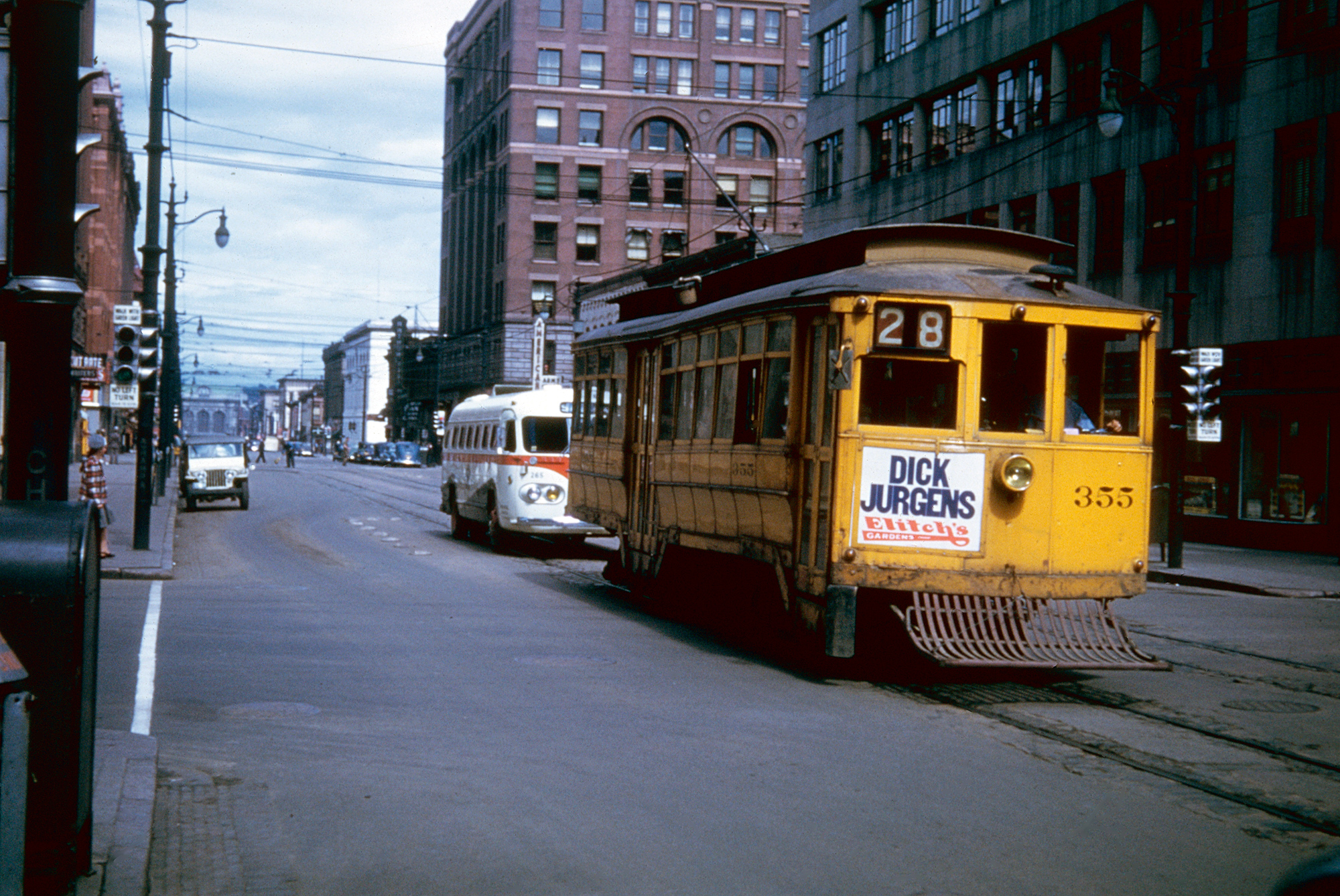 Denver & Intermountain Railroad car #355 heads southeasterly down 17th Street in Denver, Colorado in the spring of 1950. American-Rails.com collection.
Denver & Intermountain Railroad car #355 heads southeasterly down 17th Street in Denver, Colorado in the spring of 1950. American-Rails.com collection.History
What became the classic interurban all began in the 1870's with two key developments; in 1870 Zenobe Gramme unveiled a generator for commercial use while Werner von Siemens showcased the world's first electric locomotive at an exhibition in Berlin, Germany during 1879.
As these technologies found their way to the United States the first examples appeared in the 1880's; in 1880 Thomas Edison tested an experimental electric locomotive, powered by a dynamo, which was operated on a stretch of track in Menlo Park, New Jersey.
As Dr. George Hilton and John Due's authoritative piece, "The Electric Interurban Railways In America," points out the birth of the true American interurban began when Frank Sprague developed an electric motorcar in 1886 for the New York Elevated Railway whereby the motor(s) were situated between the axle, along with a trolley pole and multiple-unit control stand.
This gave way to the typical streetcar which became such a common sight throughout America. Sprague failed to interest the New York Elevated but others were impressed.
He eventually secured a contract in May of 1887 with the Richmond Union Passenger Railway in Virginia to provide cars for its operation. It opened on February 2, 1888 and proved successful.
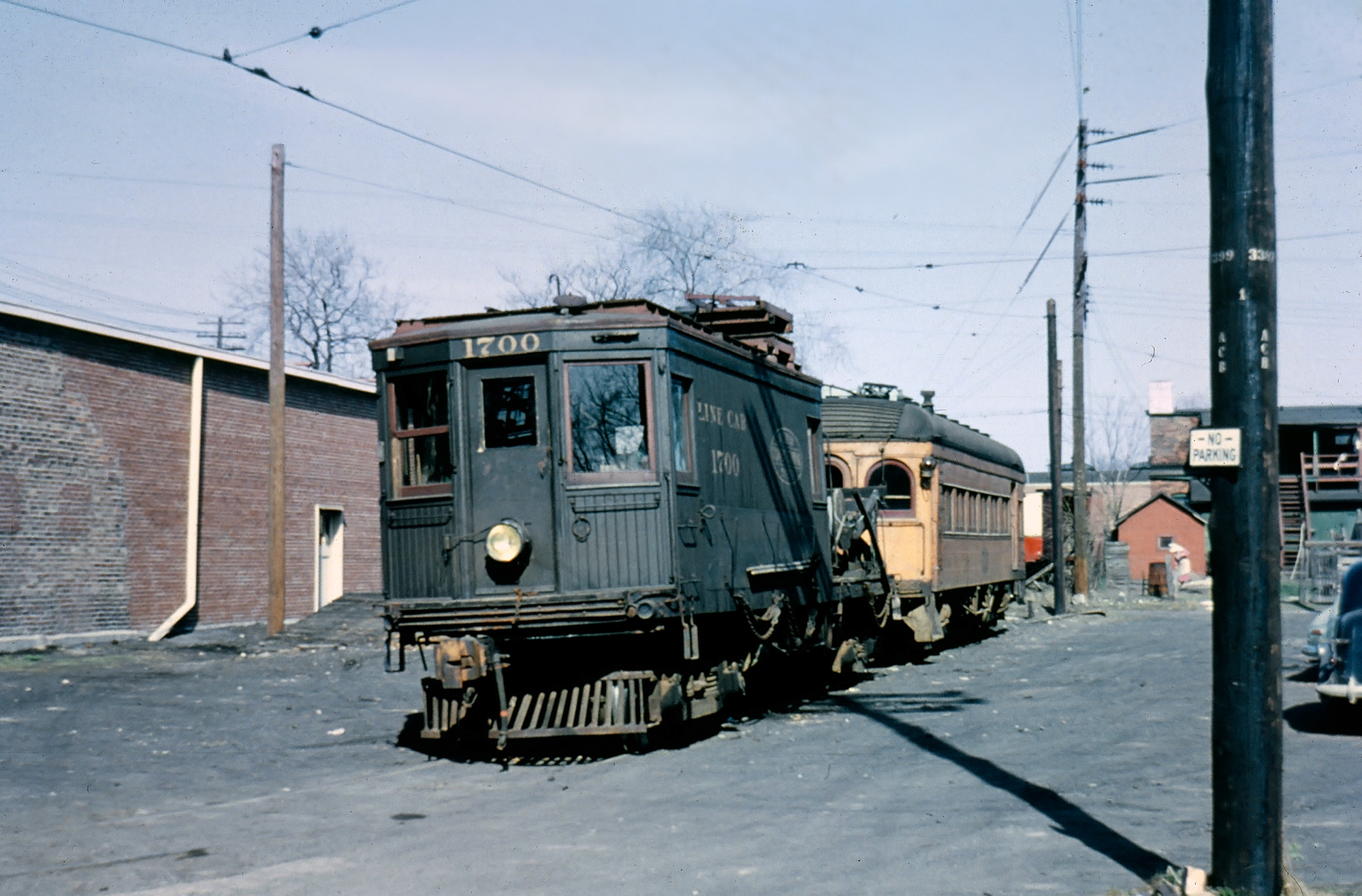 Illinois Terminal line car #1700 is seen here tied down at the small yard in Danville, Illinois, circa 1951. Such maintenance-of-way cars were common on interurbans to service the overhead catenary. James Stitzel photo. American-Rails.com collection.
Illinois Terminal line car #1700 is seen here tied down at the small yard in Danville, Illinois, circa 1951. Such maintenance-of-way cars were common on interurbans to service the overhead catenary. James Stitzel photo. American-Rails.com collection.Another important developer was Sidney Howe Short who invented a double-reduction, gearless motor and also learned that overhead catenary was the best means for electrical pickup. Short conceived another important development, the contact "shoe."
By the time main line electrified systems were introduced in 1895, when the Baltimore & Ohio energized 4 miles of its Baltimore trackage (including the 1.4-mile Howard Street Tunnel), the technology was quite advanced.
- According to the railroad's "Official List No. 29" issued January 1, 1948 the entire Belt Line ran from Milepost 90.7 at Bay View, Maryland to Milepost 97.9 at Hamburg Street, Baltimore. -
There were three great periods of interurban development; the first occurred during the 1890's and then reached a great flurry of construction between 1901 and 1904 when more than 5,000 miles were laid down.
The Panic of 1903 ended this fervor but it reignited again between 1905 and 1908 when another 4,000 miles were built.
Once more, a financial setback, the Panic of 1907, ended investment although afterwards another great construction period did not materialize. In 1889 there were just 7 miles of interurbans in service, a number which jumped to 3,122 by 1901, and finally peaked at 15,580 in 1916.
These numbers slowly receded into the 1920's as abandonment hastened through the 1930's. By 1950 just 1,519 miles remained and the number dropped to 209 miles by 1959.
As William Middleton notes in his book, "Traction Classics: The Interurbans, Extra Fast & Extra Fare, Volume II," by the end of World War I interurbans were already experiencing financial difficulty.
The interurban was conceived as a transit system, developed from the basic streetcars of the era. However, instead of serving a single municipality this new operation would link two or more.
In an era before automobiles, when steel rails handled nearly all interstate and intercity travel, the interurban concept seemed viable, in theory.
There was also the added perk of providing some freight business. As interurbans expanded they did indeed initially prove popular offering quick service, multiple schedules daily (the large Illinois Traction system, for instance, was dispatching 106 trains out of Springfield, Illinois everyday by 1906), and with fares only a few cents each way.
Depending upon cost an interurban's route either followed its own dedicated right-of-way or, with permission from the state/county, could be laid right next to a rural road.
The latter alternative was cheaper but the resulting grades and curves were less than ideal, a problem only compounded when freight movements were involved.
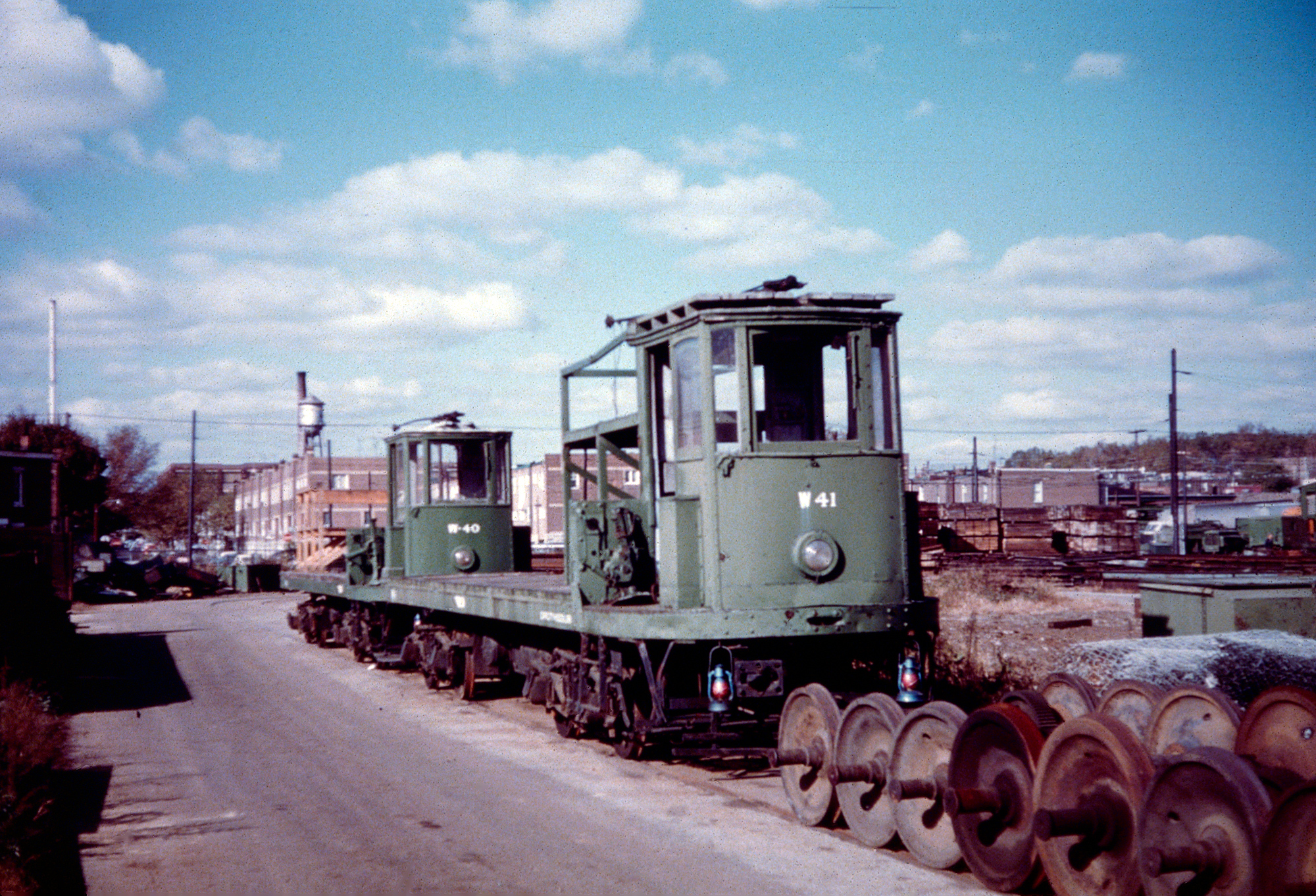 Line cars belonging to the Philadelphia Transportation Company layover at the PTC shops during the 1960s. American-Rails.com collection.
Line cars belonging to the Philadelphia Transportation Company layover at the PTC shops during the 1960s. American-Rails.com collection.Visually, the interurban was classic Americana as a car sped along a grass-covered right-of-way with its trolley pole extended high.
While postdating the industry, one the great depictions of interurban right-of-way is illustrated in Trains Magazine's October, 1993 issue under a segment entitled, "Trains Of New England: A Yankee Autumn" (Page 57).
In the scene, captured by Scott Hartley, Claremont & Concord 44-tonner #31 totes a single boxcar along the former interurban's rickety trackage skirting State Route 103 at West Claremont, New Hampshire during October of 1976.
It seems surreal that a train could actually fit on such a narrow patch of right-of-way where a railroad doesn't even appear to exist!
For power, most interurbans used overhead catenary (energized electric lines attached to line-side poles), usually rated at around 600 volts.
However, in some cases third-rail was utilized and the electricity greater. To produce the needed power either substations were built or it was purchased directly from energy companies.
While most interurbans were small, local operations this was not always the case. Those like the Illinois Terminal, South Shore Line, and Piedmont & Northern maintained more than 100 miles each and boasted an expansive freight business.
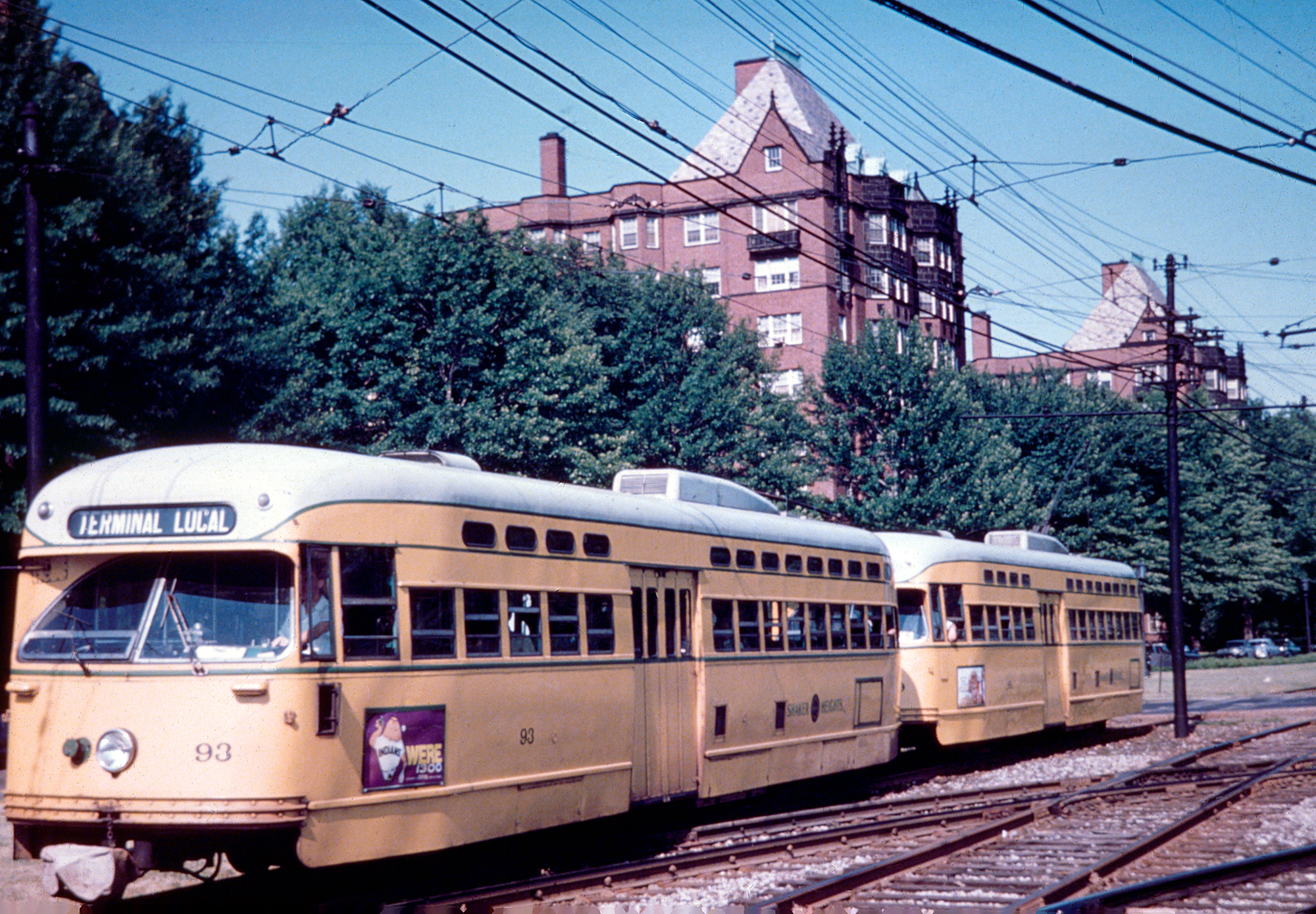 Shaker Heights Rapid Transit PCC;s #93 and #55 are along Shaker Boulevard and Van Aken Boulevard heading west at Shaker Square, Ohio (Cleveland) during the 1960s. American-Rails.com collection.
Shaker Heights Rapid Transit PCC;s #93 and #55 are along Shaker Boulevard and Van Aken Boulevard heading west at Shaker Square, Ohio (Cleveland) during the 1960s. American-Rails.com collection.Alas, the classic streetcar proved susceptible even to the earliest of automobiles and began a quick decline after World War I.
To make matters worse they contained extremely high operating ratios of 85-90% (some were even greater than 100%) while the average rate of return never exceeded 3%.
Most were gone by the immediate postwar years and only the strongest survived to see 1960. Today, some of the streetcar systems have survived for commuter service such as in Philadelphia (today, operated by the Southeastern Pennsylvania Transportation Authority or "SEPTA"), Chicago (Northern Indiana Commuter Transportation District, NICTD), and the remnants of Pacific Electric's great system in Los Angeles.
In addition, as highways grow evermore cramped, true trolley lines have returned within various cities. Below you can learn more about most of the interurbans that operated in each state. In general, the industry tended to be centered around the Midwest with Ohio the epicenter; overall, Ohio's mileage peaked at 2,798 and every town in the state larger than 10,000 was served by at least one system.
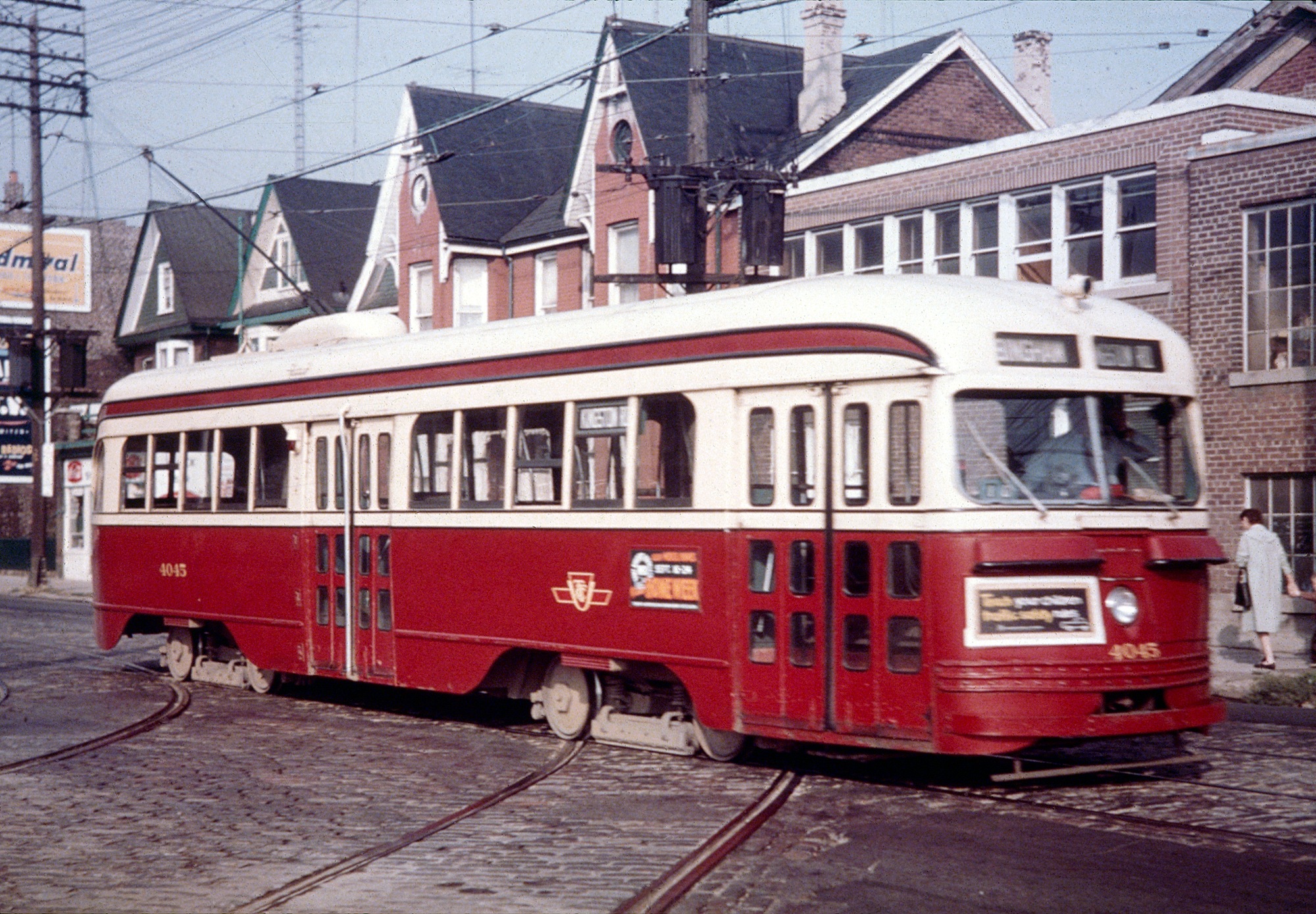 Toronto Transit (TTC) PCC #4043 nears the Connaught Carbarn on East Queen Street during the 1960s. American-Rails.com collection.
Toronto Transit (TTC) PCC #4043 nears the Connaught Carbarn on East Queen Street during the 1960s. American-Rails.com collection.If one is able to see a system map of Ohio's interurbans many are concentrated, as to be expected, around the large cities such as Cincinnati, Toledo, Columbus, Canton, Cleveland, and Dayton.
Interestingly, there were few systems southeast of Columbus with notables located around Zanesville, Ashland, and Marietta.
There were surrounding states which also had significant interurban mileage including Michigan, Illinois, Indiana, Ohio, and Pennsylvania. By contrast, the South had relatively few systems, as did much of West (due to the distance between large cities).
However, it is rather strange that the South never established a significant network of streetcar lines considering many cities were relatively close together just as in the Midwest.
Also of note was the Northeast. A few states like New York and New Jersey had a large network of interurbans but (Connecticut, New Hampshire, Rhode Island, etc.) were littered with streetcar lines serving only a particular city/town (some of these are included here for reference purposes).
Overall, if you would like to learn much more about the interurban industry and its rise and fall consider picking up a copy of The Electric Interurban Railways in America by authors George Hilton and John Due. This is the authoritative book on the subject, interesting written roughly a half-century ago but still in print.
Classic Systems
Chicago, South Shore & South Bend ("South Shore Line")
Chicago, Aurora & Elgin Railroad
Chicago, North Shore & Milwaukee ("North Shore Line")
Denver & Intermountain Railroad
Lackawanna and Wyoming Valley Railroad
Portland Traction Company, "PEPCO"
Fonda, Johnstown & Gloversville
Fort Dodge, Des Moines & Southern
Salt Lake, Garfield & Western Railway
Waterloo, Cedar Falls & Northern
Car Builders
Niles Car & Manufacturing Company
More Reading
A Further History of Streetcars And Trolleys
PCCs, Presidents’ Conference Committee Streetcars
By State
Iowa
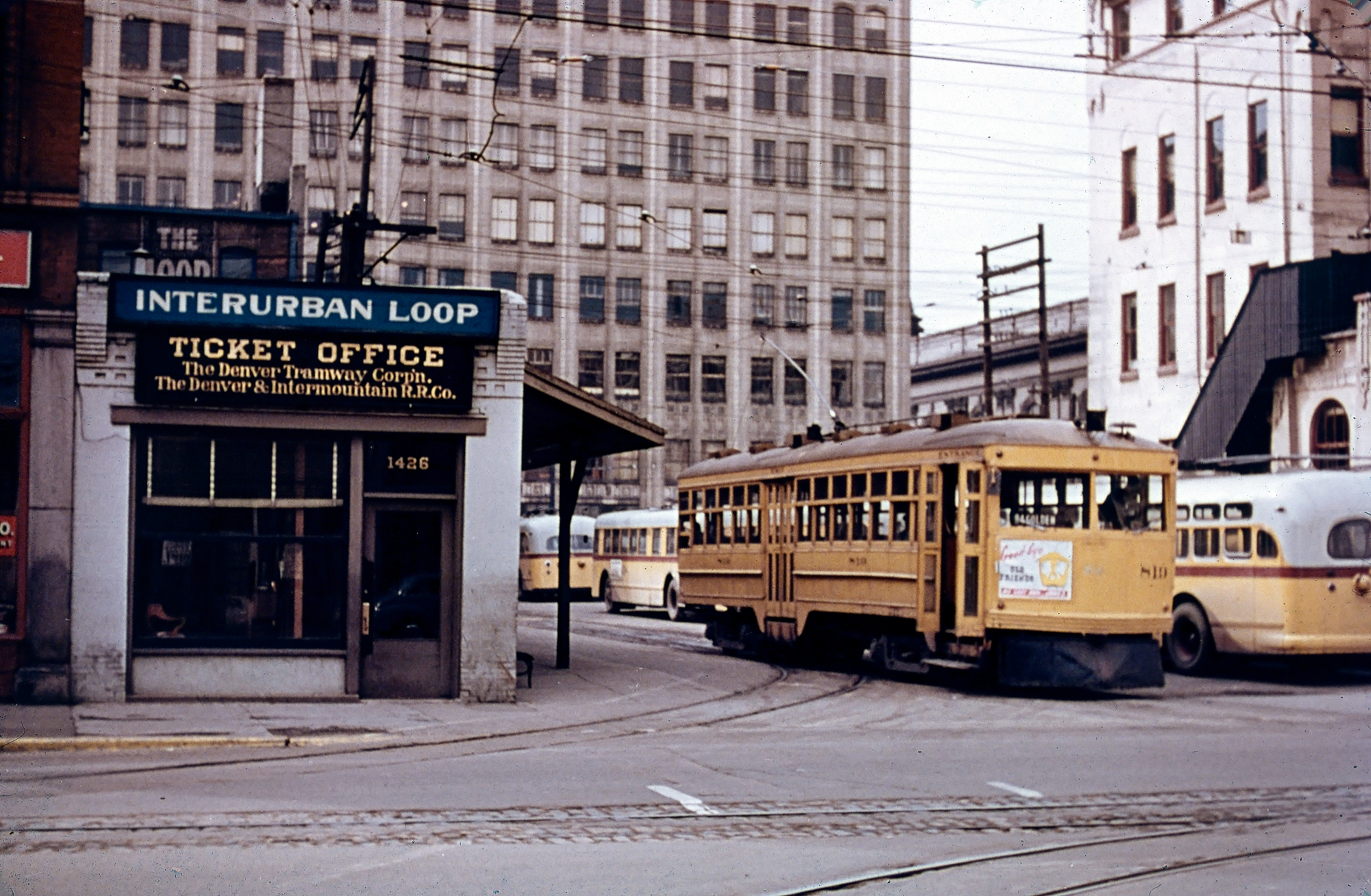 Denver & Intermountain car #819 is seen here at the downtown loop in Denver, Colorado in the spring of 1950. American-Rails.com collection.
Denver & Intermountain car #819 is seen here at the downtown loop in Denver, Colorado in the spring of 1950. American-Rails.com collection.Alaska
Tanana Valley Railroad: The Tanana Valley Railroad was a small battery-powered system that connected Chena and Fairbanks. This interurban would eventually became part of the Alaska Railroad.
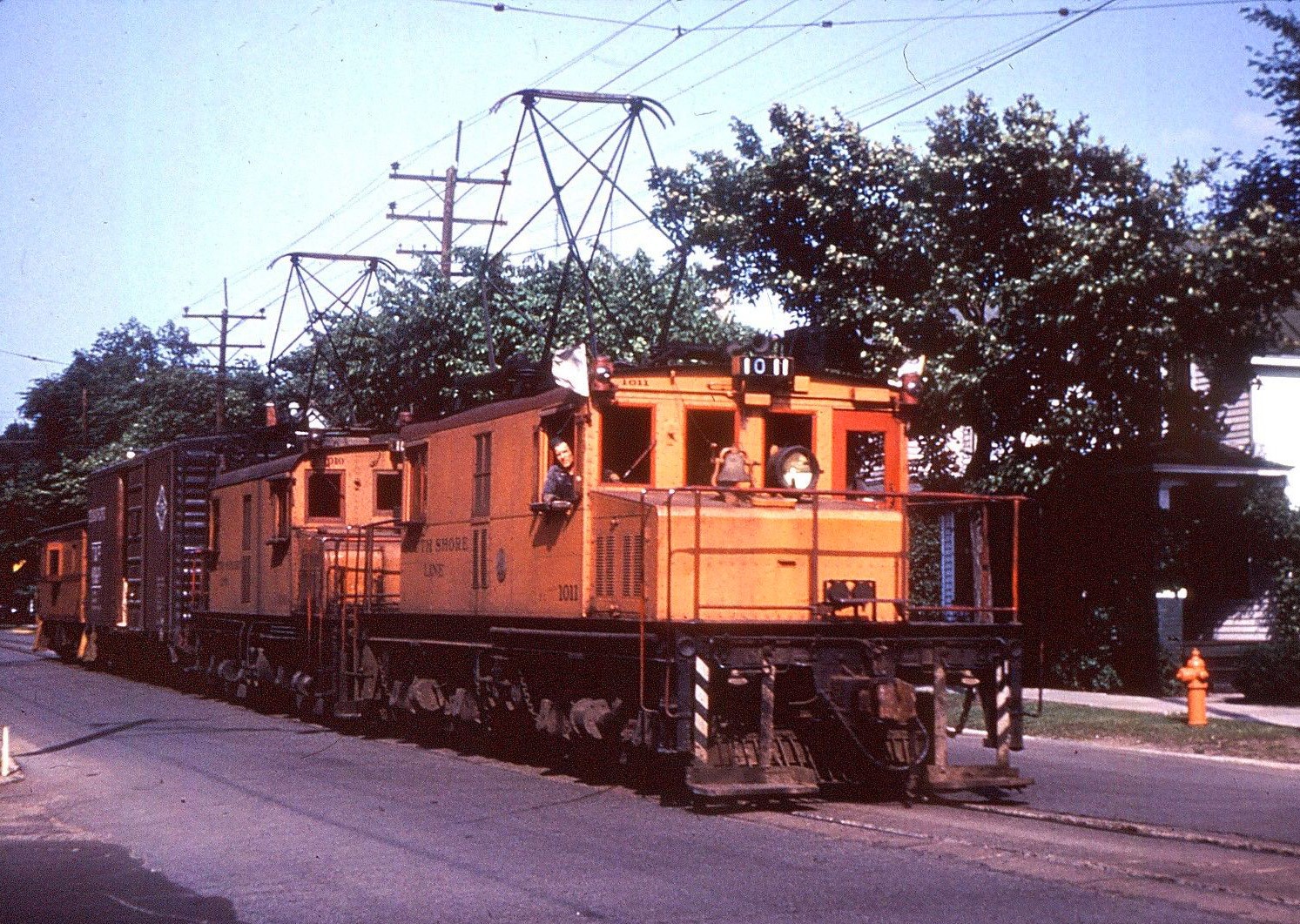 A pair of the South Shore Line's steeple-cab electrics tote a single boxcar, and trailing caboose, through the streets of Michigan City, Indiana circa 1950s. Author's collection.
A pair of the South Shore Line's steeple-cab electrics tote a single boxcar, and trailing caboose, through the streets of Michigan City, Indiana circa 1950s. Author's collection.Hawaii
Honolulu Rapid Transit: The Honolulu Rapid Transit Company served the city of Honolulu beginning operations in 1898. The famous interurban operated streetcar service until the 1940s when operations were discontinued in favor of buses.
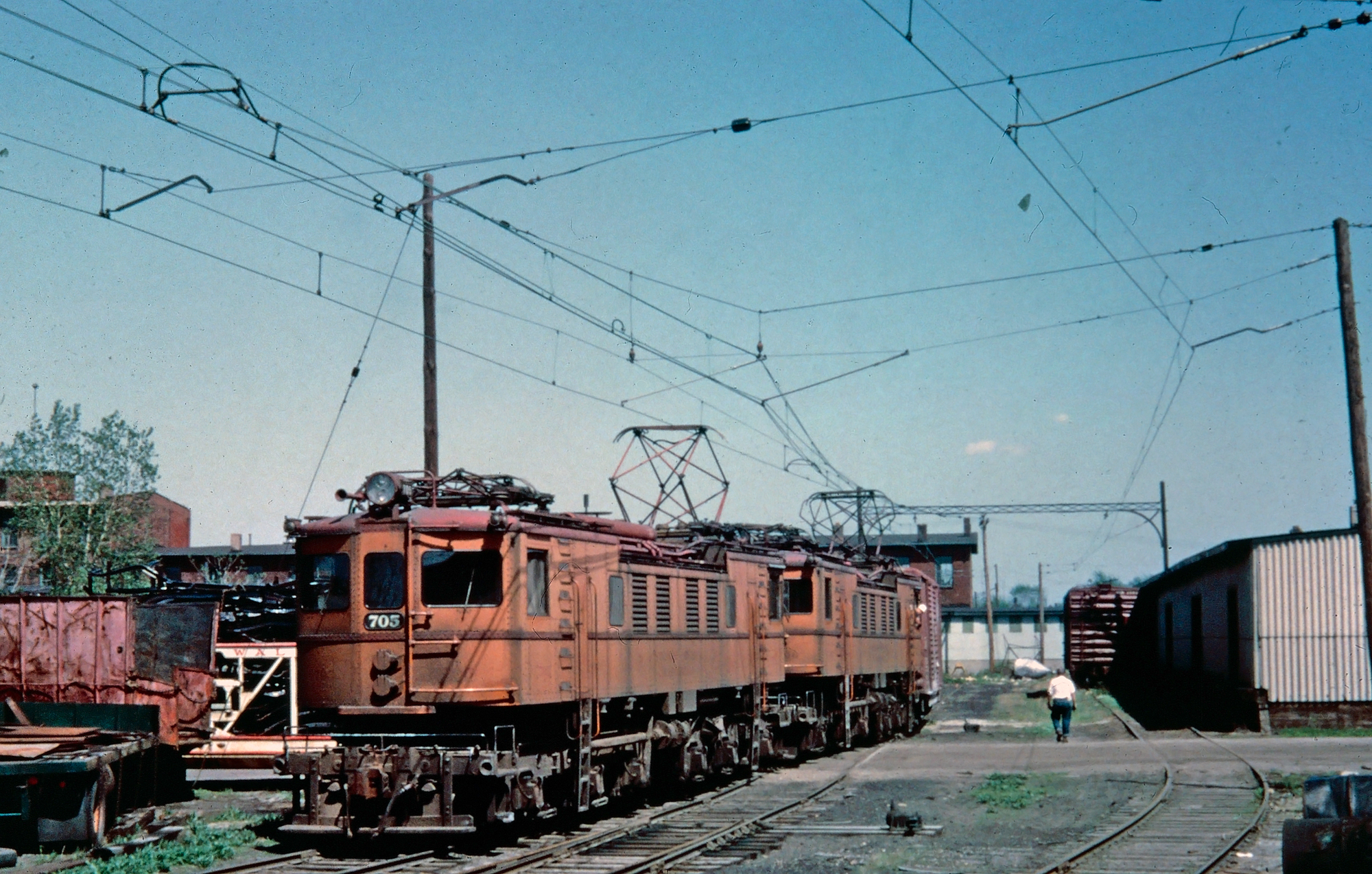 South Shore Line R-2 boxcabs #705 and #706 at work near the freight depot in South Bend, Indiana on May 10, 1964. American-Rails.com collection.
South Shore Line R-2 boxcabs #705 and #706 at work near the freight depot in South Bend, Indiana on May 10, 1964. American-Rails.com collection.Nevada
Reno Traction Company: The Reno Traction Company served its namesake city beginning operations around the turn of the century. It operated on a 600-volt DC system and acquired power by the Reno Power, Light & Water Company. It remained in service until 1927 when operations were abandoned in favor of buses.
New Mexico
City Electric Railway
Las Vegas & Hot Springs Electric Railway
North Dakota
The Capitol Line: The Capitol Line served the capitol building in Bismark on a one-mile system that was state-owned and operated.
Grand Forks Street Railway: The Grand Forks Street Railway served the City of Grand Forks beginning operations in 1908 and taking over from the Grand Forks Transit Company of 1904. Streetcar service on the line lasted until 1934.
Valley City Street & Interurban Railway: The Valley City Street & Interurban Railway began operations in 1905 connecting its namesake city. Streetcar service was abandoned in 1948.
Wahpeton Breckenridge Street Railway: The Wahpeton Breckenridge Street Railway served Wahpeton beginning operations in 1910 and discontinuing service in 1925.
Northern States Power Company
South Carolina
Anderson Traction Company: The Anderson Traction Company began operations in 1904 serving its namesake city. It was renamed the Greenville, Spartanburg & Anderson Railway in 1909 and again changed hands in 1924 as the Southern Public Utilities Company before abandoning streetcar operations in 1934.
Spartanburg Railway Gas & Electric Company: The Spartanburg Railway Gas & Electric Company served the Spartanburg area beginning operations in 1900.
In 1912 it was renamed the South Carolina Light Power & Railway Company and changed hands twice more (South Carolina Electric & Gas Company, 1912; Southern Public Utilities Company, 1928) before abandoning operations in 1935.
Columbia Street Railway
South Dakota
Mitchell Street & Interurban Railway: The Mitchell Street & Interurban Railway began operations around the turn of the century serving Mitchell operating a 7-mile system that was electrified in 1913. The operation was never profitable and discontinued service soon after electrification.
Sioux Falls Traction System: The Sioux Falls Traction System served its namesake city beginning operations in 1908 and abandoning service in 1930 in favor of buses.
Utah
Bamberger Electric Railroad: The Bamberger Electric Railroad (originally known as the Salt Lake & Ogden Railway, but changed its name in 1917) began operations in 1908 although the system dated back to the Great Salt Lake & Hot Springs Railway of the 1890s.
At its peak the system connected Ogden and Salt Lake City on a line that was built to very high standards. It was electrified soon after its 1908 opening and carried heavy freight and passenger traffic during its early years.
The depression was unkind to the system and it fell into bankruptcy in 1933 emerging as the Bamberger Railroad in 1939. In 1957 the system was sold to investors, which sold portions of the line to Union Pacific and Denver & Rio Grande Western in 1958.
Utah-Idaho Central Railroad: The Utah-Idaho Central Railroad dates back to the Ogden Rapid Transit Company of 1900.
At its peak this system would operate 95 miles of railroad between Ogden, Utah and Preston, Idaho. The Utah-Idaho Central Railroad began operations in 1918 and operated until February of 1947 when operations were abandoned.
Ogden Rapid Transit Company: The Ogden Rapid Transit Company began operations in 1900 taking over that of the Ogden Electric Railway. The system became part of the Utah-Idaho Central Railroad in 1918.
Salt Lake, Garfield & Western Railway
Wyoming
Sheridan Interurban Railway
Thanks to Ken Johnsen and Yakima Valley Trolleys for help with the information on this page.
Contents
Recent Articles
-
Nevada - Wine Tasting - Train Rides
Dec 28, 25 03:26 PM
While it may not be the first place that comes to mind when you think of wine, you can sip this delight by train in Nevada at the Nevada Northern Railway. -
New Hampshire - Wine Tasting - Train Rides
Dec 28, 25 03:22 PM
This article details New Hampshire's most enchanting wine tasting trains, where every sip is paired with breathtaking views and a touch of adventure. -
Virginia - Murder Mystery - Dinner Train Rides
Dec 28, 25 12:23 PM
Among the state's railroad attractions, murder mystery dinner trains stand out as a captivating fusion of theatrical entertainment, fine dining, and scenic travel.



